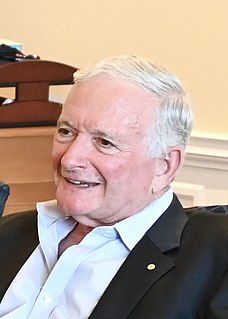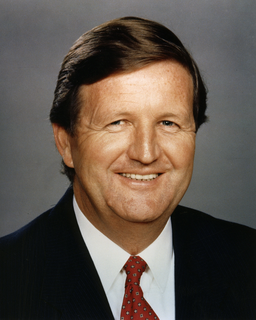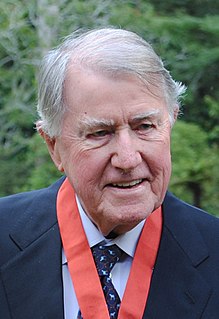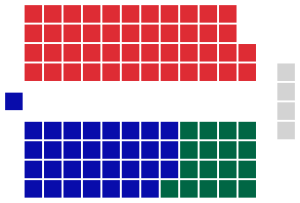
Nicholas Frank Hugo Greiner (;) is an Australian politician who served as the 37th Premier of New South Wales from 1988 to 1992. Greiner was Leader of the New South Wales Division of the Liberal Party from 1983 to 1992 and Leader of the Opposition from 1983 to 1988. Greiner had served as the Federal President of the Liberal Party of Australia from 2017 to 2020. He is the current Consul-General in the United States of America, New York.
Members of the New South Wales Legislative Assembly who served in the 50th parliament held their seats from 1991 to 1995. They were elected at the 1991 state election, and at by-elections. The Speaker was Kevin Rozzoli.</ref>

Ku-ring-gai is an electoral district of the Legislative Assembly in the Australian state of New South Wales. Since 2015 it has been represented by Alister Henskens of the Liberal Party. The electorate covers the suburbs and parts of the suburbs of Gordon, Hornsby, Killara, Lindfield, Normanhurst, North Turramurra, North Wahroonga, Pymble, South Turramurra, Thornleigh, Turramurra, Wahroonga, Waitara, Warrawee and West Pymble.

Elections to the 52nd Parliament of New South Wales were held on Saturday, 27 March 1999. All seats in the Legislative Assembly and half the seats in the Legislative Council were up for election. The Labor Party, led by premier Bob Carr won a second term with a 7% swing against the Liberal Party and National Party, led by Kerry Chikarovski.

Elections to the 51st Parliament of New South Wales were held on Saturday 25 March 1995. All seats in the Legislative Assembly and half the seats in the Legislative Council were up for election. The minority Liberal Party-led Coalition government of Premier John Fahey was defeated by the Labor Party, led by Opposition Leader Bob Carr. Carr went on to become the longest continuously-serving premier in the state's history, stepping down in 2005. Fahey pursued a brief career as a Federal Government minister.

Elections to the 49th Parliament of New South Wales were held on Saturday 19 March 1988. All seats in the Legislative Assembly and a third of the seats in the Legislative Council were up for election. The Labor government of Premier Barrie Unsworth was defeated by the Liberal-National Coalition, led by Opposition Leader Nick Greiner.

A general election was held in the state of New South Wales, Australia, on Saturday 7 October 1978. The result was a landslide victory for the Labor Party under Neville Wran, popularly known as the "Wranslide."
Allan Andrews is a former Australian politician. A member of the Liberal Party, he represented the electoral district of Heathcote in the New South Wales Legislative Assembly for a single term, from 1988 to 1991.
Terry Alan Metherell is a former Australian politician who represented the Electoral district of Davidson in the New South Wales Legislative Assembly from 1981 to 1992. When the Liberal Party won the 1988 election, Premier Nick Greiner appointed him Minister for Education and Youth Affairs, a portfolio he held until 1990. In October 1991, he resigned from the Liberal party and remained in Parliament until his resignation to take up an offer of a public service job. This offer led to the downfall of Greiner, who was found to have corruptly offered the position to force a by-election in Metherell's district.

Elections to the 55th Parliament of New South Wales were held on Saturday, 26 March 2011. The 16-year-incumbent Labor Party government led by Premier Kristina Keneally was defeated in a landslide by the Liberal–National Coalition opposition led by Barry O'Farrell. Labor suffered a two-party swing of 16.4 points, the largest against a sitting government at any level in Australia since World War II. From 48 seats at dissolution, Labor was knocked down to 20 seats—the worst defeat of a sitting government in New South Wales history, and one of the worst of a state government in Australia since federation. The Coalition picked up a 34-seat swing to win a strong majority, with 69 seats–the largest majority government, in terms of percentage of seats controlled, in NSW history. It is only the third time since 1941 that a NSW Labor government has been defeated.
John David Booth, was a Liberal Party member of the New South Wales Legislative Assembly, representing the electorate of Wakehurst from 24 March 1984 to 3 May 1991.

The 1956 New South Wales state election was held on 3 March 1956. It was conducted in single member constituencies with compulsory preferential voting and was held on boundaries created at a 1952 redistribution. The election was for all of the 94 seats in the Legislative Assembly.

The 1962 New South Wales state election was held on 3 March 1962. It was conducted in single member constituencies with compulsory preferential voting and was held on boundaries created at a 1961 redistribution. The election was for all of the 94 seats in the Legislative Assembly.

The 1968 New South Wales state election was held on 24 February 1968. It was conducted in single member constituencies with compulsory preferential voting and was held on boundaries created at a 1966 redistribution. The election was for all of the 94 seats in the Legislative Assembly. The Liberal Party, led by Premier Robert Askin, in Coalition with the Country Party of Deputy Premier Charles Cutler, was elected for a second term—the first time that a non-Labor government had been reelected since before World War II.

The 1965 New South Wales state election was held on 1 May 1965. It was conducted in single member constituencies with compulsory preferential voting and was held on boundaries created at a 1961 redistribution. The election was for all of the 94 seats in the Legislative Assembly.

New South Wales politics takes place in context of bicameral parliamentary system. The main parties are the Liberal and National parties of the governing Coalition and the Australian Labor Party. Other minor political parties include the Greens, Shooters, Fishers and Farmers Party, the Christian Democratic Party, the One Nation, the Liberal Democratic Party and the Keep Sydney Open..

A by-election was held for the New South Wales Legislative Assembly seat of Ku-ring-gai on Saturday, 22 August 1992.
The Greiner–Murray ministry (1988–1991) or First Greiner–Murray ministry or First Greiner ministry was the 80th ministry of the New South Wales Government, and was led by the 37th Premier of New South Wales, Nick Greiner,, representing the Liberal Party in coalition with the National Party, led by Wal Murray,.

The Greiner–Murray ministry (1991–92) or Second Greiner–Murray ministry or Second Greiner ministry was the 81st ministry of the New South Wales Government, and was led by the 37th Premier of New South Wales, Nick Greiner, representing the Liberal Party in coalition with the National Party, led by Wal Murray.
A by-election was held for the New South Wales Legislative Assembly seat of Gordon on 2 May 1992 because of the resignation of Tim Moore, following the release of the findings of the Independent Commission Against Corruption into the 'Metherell Affair'.













